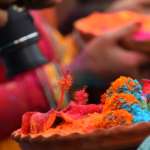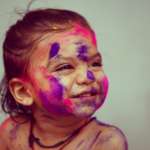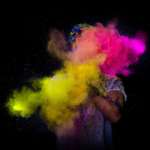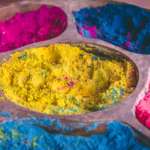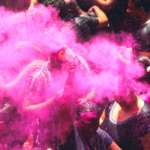When did the Holi: The Festival Of Love start?
Gallery Caption: Holi: The Festival Of Love. Images source Unsplash.comAbout Holi: The Festival Of Love Festival
Holi is a popular Hindu festival celebrated all over India and abroad. It is commonly known as the 'festival of colors' or the 'festival of love'. Holi symbolizes the victory of good over evil and the arrival of spring. People celebrate Holi by smearing powdered and liquid colors on each other, playing holi songs, and enjoying sweet delicacies. People from all walks of life come together in groups and celebrate this festival with lots of enthusiasm and joy. Holi is also a great way to spend quality time with family and friends. The streets become vibrant with happy and colorful people. People share snacks, sprinkle gulal (red powder), and exchange greetings and embrace each other regardless of caste, creed, religion, or any other differences.
Introduction
India is a sacred country. In India, there are many religions, and the majority is the Hindu religion. In India, there was a time when it has 365 festivals means Indians want an excuse to celebrate each and every day, but now the quantity is somewhat reduced. From the list of major Hindu festivals, Holi is one. There are many rituals in Holi, and this festival is dedicated to spreading happiness, colours and love in the hearts. So this article is dedicated to one of the most celebrated festivals in India. Its time to open your brain so that the festival of Holi to receive its essence.
Holi is a national holiday as well as a festival which comes in March every year just after the full moon day of this month March and during this time winter ends and the summer season starts in India. The dates vary according to the full moon. In the 2020 year the Holi festival is celebrated on March 10th, with Holika Dahan vary March 9. And in 2021, Holi is on 29th March and Holika Dahan on March 28. Holi is a Hindu festival, but it also becomes popular in non-Hindus in North America, Europe and many other countries which are also mentioned In this article.
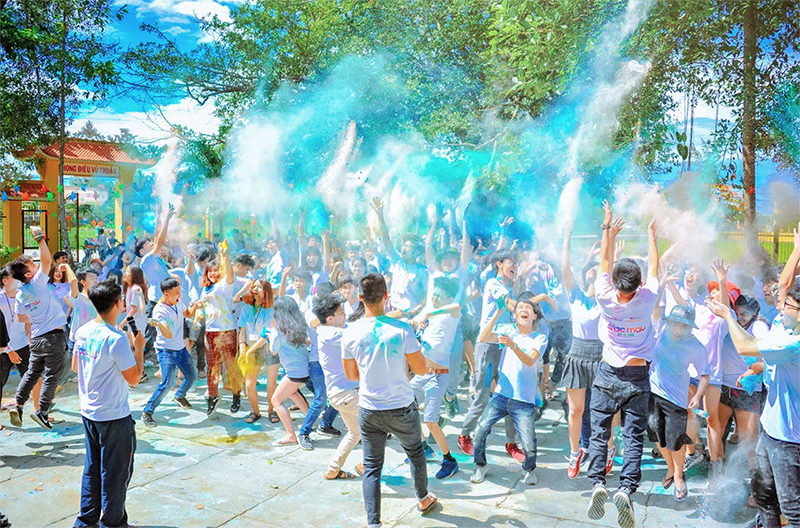
Image: Holi
Holi – History and Significance
Everything which is happened in the past is referred to as history in the present. We need history because history tells everything about why the particular thing is happening in the present.
So there is a history of Holi too in the form of true sacred stories. This section of the article will tell about some familiar stories behind the Holi.
Prahlad story
This story is of the time when, days, month and year were calculated astrologically like with stars, planets, earth and sun position in the solar system.
Once upon a time, there was a devil king ‘Hiranya Kashyap’, who is very cruel and always tortured the human beings for just of his fun, he has one son named Prahlad who is the worshipper Hindu God Vishnu. Prahlad is a teenager who only no the word Vishnu and whenever Hiranya Kashyap asks ‘who is the strongest men in the cosmos?’ then his son always told ‘the one and only lord Vishnu’ as he is the devotee of him but his father wants to listen to his name as an answer with this question. So this devil starts to hate his own son and wants to kill Prahlad. He tries everything to kill the Prahlad but nothing works so he called his sister named Holika, she has the superpower or blessing with lord Brahma that no fire can kill her.
So Hiranya Kashyap arrange a fire in the death bed and told her sister to get sat on the death bed along with Prahlada, and he sat the fire on her, but suddenly a miracle happens that Prahlada is not burning in the fire due to lord Vishu’s blessing and his devotion towards him but the Holika burned to ashes in that fire.
Due to this occasion, Holika Dahan celebrated every year one day before the day of Holi where peoples fire up the bundle of woods and burn up their jealousy, hatred, etc. into the fire. And the next following day these peoples give and take love to everyone including their enemies. As per religious rules, no fighting on this day but only spread love and joy through colours. And this also celebrated as a triumph of good over the bad.
Legend about Krishna
In one of the regions of India, in In Braj, where the supreme Lord Krishna was born and grew up, the people is celebrating the Holi festival until the Rang Panchamifestival, in the memory of the divine and unique love between Krishna and Radha (in the Sanskrit language: राधा, IAST: Rādhā, and is also called Radhika). The festival is celebrated in spring, along with another major festival Holi that is a festival of love. During Krishna’s childhood as a baby, a bad women Putana comes and poisoned him with her breast milk. This result in Krishna’s skin colour to twilight sky blue. When Krishna become a teenager, Krishna has despaired whether Radha is going to love him or not. So his mother told Krishna to ask Radha to colour his face in any colour. Radha coloured his face and she becomes a couple with Krishna. And every year a day she colours Krishna and now this day is celebrated as Holi.
Cultural significance
Holi has a cultural significance among Hindus in various subcontinents of India. It is the day when everybody should forget past sins and errors as it has no values present and thinking these past errors you are creating errors in your present which is the truth and going to affect your future a lot. So forget yourself and other mistakes. Spread love, joy, bliss, happiness, enthusiasm, to the universe and give the same ultimate wellbeing also to yourself. Holi also is the symbol of the beginning of spring. For many, this day is the starting of the new year and for some is to enjoy the transition of seasons and for some its time to make new friends. This also gives knowledge about the question, why Holi festival?
Rituals in Holi festival
Holi rituals mean practices and works performed during the Holi festival, rituals made the fun of the festival and playful and it is the festival to make your playful in every aspect of your life so that you will not entangled in the Karmic structure.
Here are some beautiful and amazing rituals performed during the Holi festival.
Holika Dahan
As it is also mentioned in the upper section of the article that Holika Dahan is performed one day before the main Holi festival. Holika Dahan is celebrated in night time in India by Hindus.
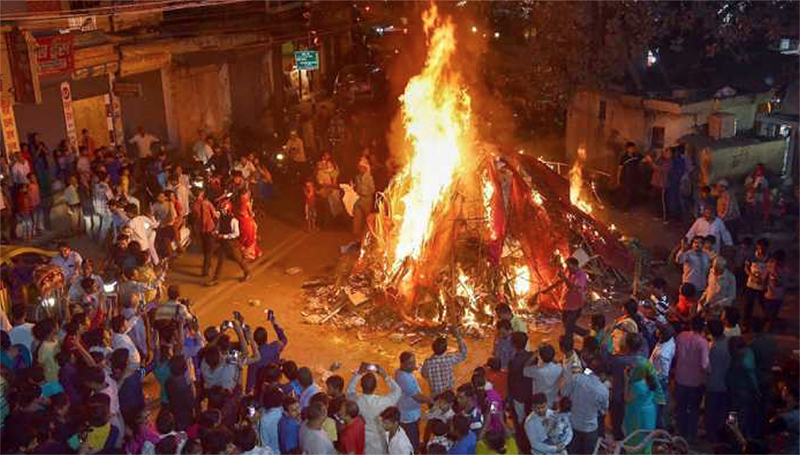
Image: Holika Dahan
In this night a group of peoples collect the woods and arrange it in triangular shape and set it to fire, then they do ‘Parikrama’ (An religious practices which include 3,5,7 etc. holy rotation around the burning woods) and throw the holy mixture and throw all bad habits and feelings of jealousy, hatred, sadness, and all mental impurities and disorders in the holy bonfire. And they all gather ground the fire and perform singing and dancing joyfully. This festival is also somewhat similar to Lori festivals of Punjab.
Play
Playing with colours
This is the most famous play in India and other Holi celebrating regions. In the western and northern region of India, colour play and Holi celebration start from the morning after the night of Holika Dahan. There are no such traditions like puja and prayer in the Holi festival, as it is the day for praying and full enjoyment. Everyone is celebrating Holi with full involvement, all of them have dry colours, different coloured solutions, and water guns that are named Pichkari in Hindi, also using wet colours they fill water balloons or they use coloured water. Some only play natural and harmless Holi with clean water to avoid any damage to the skin.
Other variation
In the Braj, the north region of India, Holi continues more than one week until Rang Panchami arrives as the last day of Holi. From this week there is a day when men cover themselves with shields and now the women have rights to beat them playfully with sticks on their shields.
In South India, people are doing an act of worship and make offerings to the God of love or desire ‘Kamadeva’. In Sanskrit language: कामदेव, IAST: Kāmadeva.
The party ends
After a full day of colours and fun, people take bathe and clean up the coloured clothes and wear new clothes to go to relatives and neighbours to greet and exchange sweets. As Holi is a day to ritually create peace, love, joy, bliss and harmony in the society.
Holi Colours
Classical natural colours
During the Holi, the winter seasons transits to spring and due to this climatic change the cough and cold are normal but if some have low immune, they can also have short term fever. Traditional colours are developed under the Aryuvedic system. These colours made from natural sources like bilva, neem, haldi, kumkum and other medicinal herbs which do not give any harm to skin, body and health.
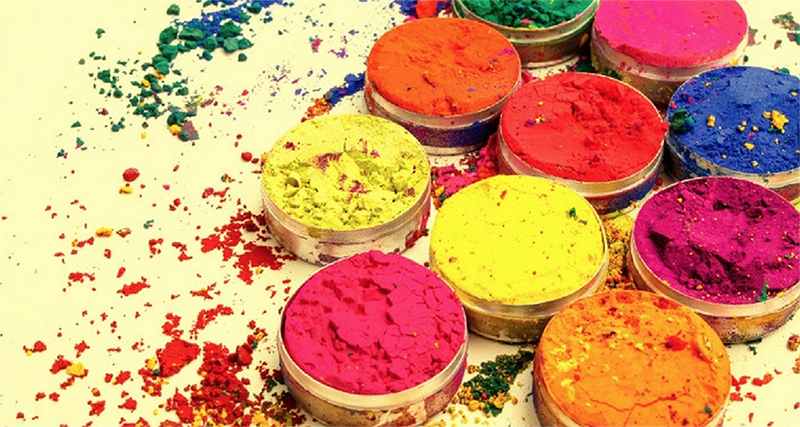
Image: Holi Colours
Green
The green colour of Holi is made from dried leaves of Gulmohar (scientific name: Delonix regia) tree and Mehendi. There is another source of natural green colour, there are used leaves of the spring corps and also the herbs.
Red and orange
The beautiful flowers of tesu tree or Palash which are also known as the flame of the jungle or forest, are the primary source of obtaining deep orange and bright red colours. Madder tree, radish, hibiscus, pomegranate and powdered fragrant of red sandalwood are the alternative sources of obtaining red. Mixing turmeric with lime powder is the alternate source of getting orange colour in powder form; also, oranges comes with boiling saffron (Kesari) in water.
Yellow
The yellow colour generally comes from turmeric (Haldi) powder. Sometimes turmeric is mixed with gram (chickpea) or any other natural flour to get the cool shade. To get another natural yellow colour, are used Bael fruit, some species of chrysanthemums and marigold and amaltas.
Purple and Magenta
Magenta and purple colour are traditionally made from the beetroot. To prepare coloured water for the Holi festival plays it is boiled directly in water.
Black and brown
Species of grapes like black grapes, amla fruits and vegetable carbon offer black and grey colours.
Brown is obtained from dried tea leaves and on boiling produce brown coloured water. Some clays are also used to produce a brown colour.
Synthetic Colours
Market of synthetic and chemical colour has grown much in India because of more appealing colours as they come with more variations but they will never ever can take the place of natural colour as because chemicals are anyway harmful to skin as it cause skin irritation inflammation and even to skin cancer if the chemical is the only thing in the colours.
But it is mainly using by those who are not aware of the harmful and cohesive effects of these colours so here is the research which might raise your awareness to some extent that usage of these synthetic colour can be totally stopped.
In 2007, according to research malachite green is a chemical of bluish-green dye is used in colours of Holi in Delhi (Capital of India) which caused severe eye irritations if eyes are not washed immediately upon exposure. Furthermore, the study found that this chemical did not penetrate the cornea, but anyway, it’s harmful.
So now it may raise your awareness towards these synthetic colours, so the one thing that this article reader can do to spread this awareness further so that nobody will use synthetic colour in Holi, as it is the festival of love and safety but no to spread diseases.
Holi celebration in out of India
During the passage of time the Holi becomes more and more popular in other countries too so here is the list of countries celebrating Holi.
| Holi celebrating regions (out of India) | Holiday or not |
| Suriname | Yes, it is a national Holiday |
| Trinidad and Tobago | No |
| Guyana | Yes, it is a public Holiday |
| Fiji | No |
| Mauritius | No |
| United States (Spanish Fork, Houston, Dallas, New Brunswick, South El Monte, Boston, Potomac and Chicago are place known to celebrate Holi in US.) | Not a public Holiday but the people take leave from work by themselves to celebrate Holi. |
| Pakistan | Holiday for Hindus only. |
Conclusion
Now the definition of Holi, its significance, the reason behind the Holi festival is may be cleared with this article but at the end here is a message. If you want to celebrate Holi, then you should because it’s the festival of hearts. Use only natural colours made by the natural ingredients like flowers, leaves and herbs as these will not t damage you and will these Aruvedic colour will give benefits along with the colour play.
Spread the happiness, love and all good feelings and energy in society and hearts so that this beautiful earth can support the life in you. Do not get angry; do not get jealous.
How to Say "Holi: The Festival Of Love" In Different Languages?
- Aboriginal
- Ngalindi (ad-AU)
- Bengali
- হোলি (bn-BD)
- Chinese
- 節日之愛 (zh-CN)
- French
- Fête d'Amour (fr-FR)
- German
- Festival der Liebe (de-DE)
- Greek
- Φεστιβάλ Αγάπης (el-GR)
- Hebrew
- חולי: חג האהבה (he-IL)
- Hindi
- होली : स्नेह का त्योहार (hi-IN)
- Indonesian
- Pesta Cinta (id-ID)
- Italian
- Festa d'Amore (it-IT)
- Japanese
- 愛の祭典 (ja-JP)
- Māori
- Uta mārie (mi-NZ)
- Persian
- فستیوال عشق (fa-IR)
- Portuguese
- Festival de Amor (pt-BR)
- Romanian
- Festivalul Dragostei (ro-RO)
- Russian
- Фестиваль любви (ru-RU)
- Spanish
- Festival del amor (es-PE)
- Tagalog
- Festival ng Pag-ibig (tl-PH)
- Zulu
- Umcasho Wendlovu (zu-ZA)
Holi: The Festival Of Love Also Called
The Festival of Colors, or Rang Panchami, is another name for Holi: The Festival of Love.Countries where "Holi: The Festival Of Love" is celebrated:
- :: Asia
- :: India
- :: Nepal
- :: Oceania
- :: Fiji
- :: South America
- :: Guyana
- :: Suriname
FUN FACT:
In year 4th century, Holi: The Festival Of Love is celebrated on March 6 for the first time.FESTIVAL CHECK: We strive for accuracy and fairness. But if you see something that doesn't look right, please click here to contact us!


